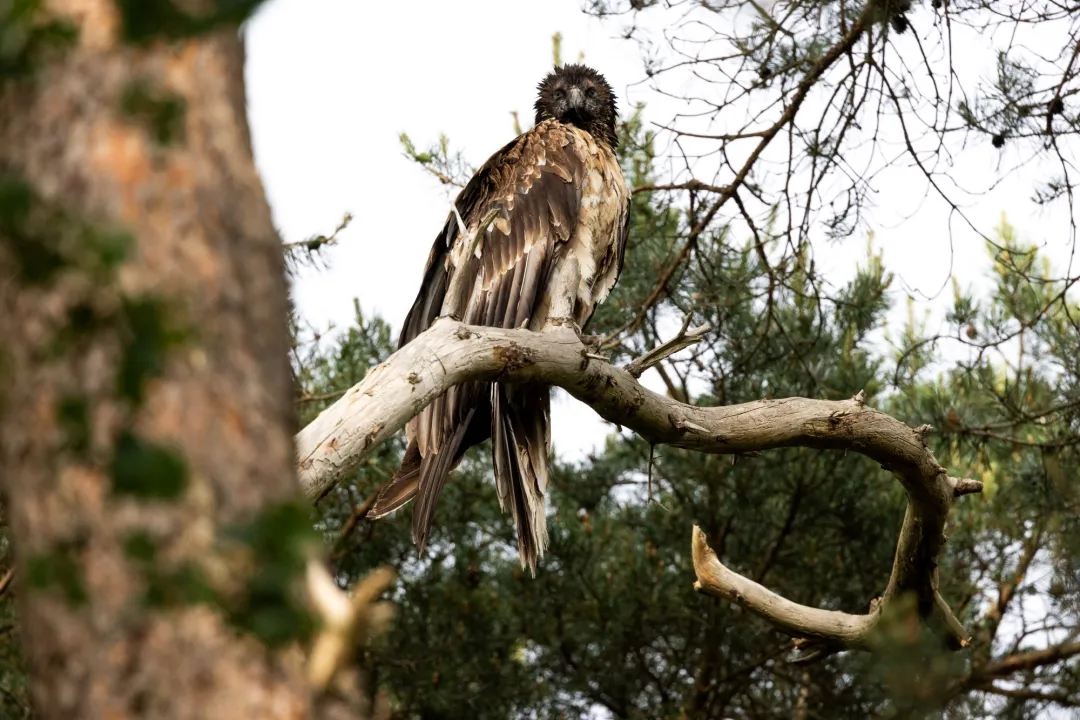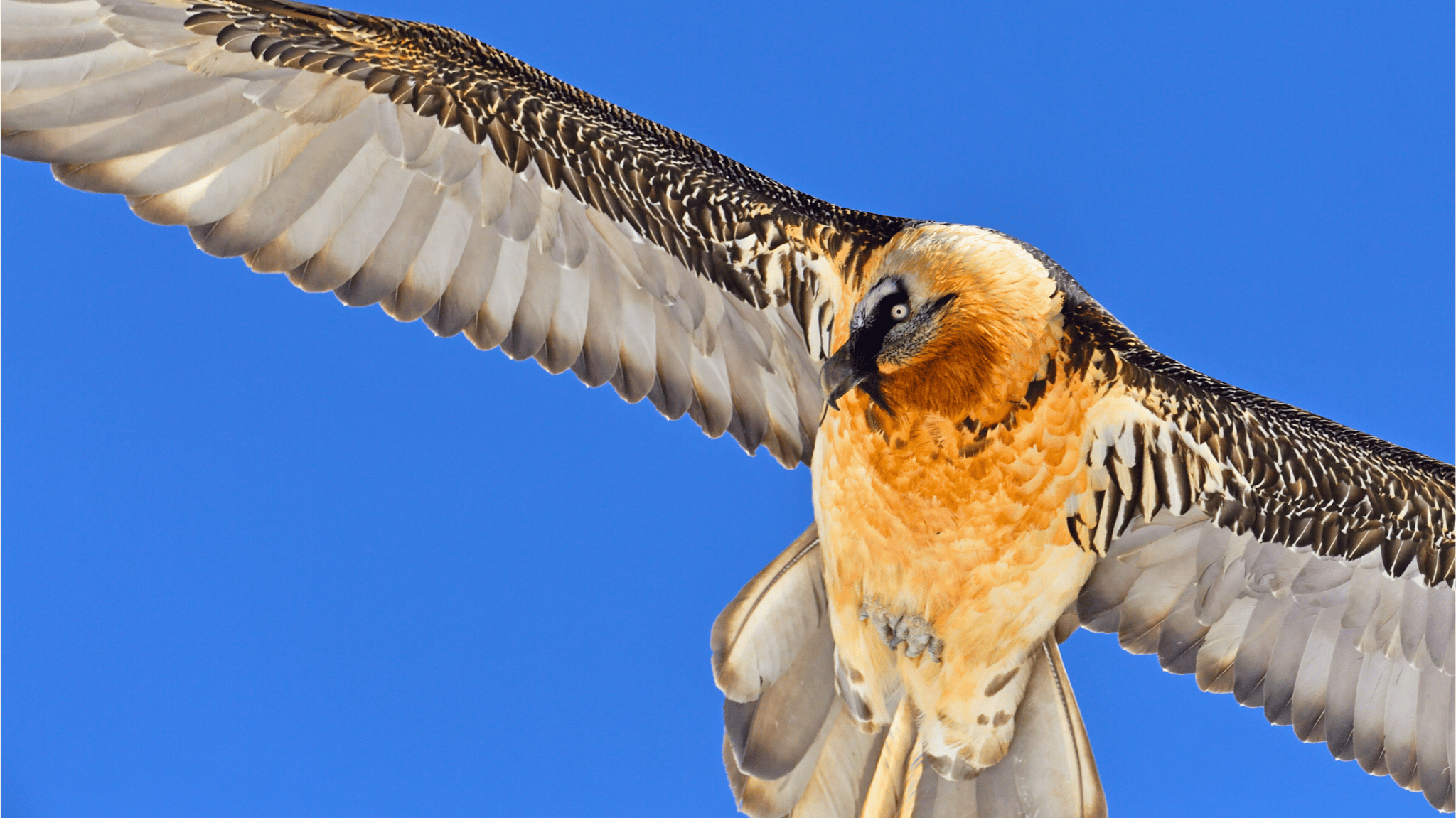
Unfortunately, Buisson, one of the nine Bearded Vultures we reintroduced this year as part of LIFE GYPCONNECT, has met a tragic end. Just after two days from his first flight, the vulture collided with a power line and died.
Releasing Buisson
The LIFE GYPCONNECT team released Buisson at an aviary in the wild alongside Bearded Vulture Cévennes. It was the final release of young birds of the year under this LIFE project and took place on Friday 3 June at the Parc Naturel Régional des Grands Causses. Despite the bad weather, the two birds settled into their release site and their new surroundings very quickly. They also had some curious visitors, including Bearded Vulture Kirsi who was released at the same place in 2013. Buisson and Cévennes quickly accustomed to one another. They fed well and flapped their wings quite often. On 2 July, Buisson took flight under the watchful eyes of Cevennes who followed a few hours later. Even though Buisson’s first flights were short with uncontrolled landings, they could have improved in the upcoming days. But, Buisson didn’t make it.
Collision with a power line

On 4 July, just two days after his first flight, the LIFE GYPCONNECT team found Buisson electrocuted under a power line. This power line was even equipped with visual systems designed to allow birds to identify and avoid it, but Buisson still collided with it.
His body was quickly recovered and taken to the veterinarian of the Centre National d’Informations Toxicologiques Vétérinaires, Florence Roque. The results of the autopsy did not reveal any other symptoms that could have caused the death of the bird.
The news of the death of Buisson saddened the whole team involved in releasing the bird, especially considering all the effort required. Nevertheless, as unfortunate as this event may be, it will in no way hinder our motivation to continue reintroducing Bearded Vultures into the wild across Europe. Over the past few years, the LIFE GYPCONNECT project has released a total of 27 Bearded Vultures into the wild. This year, we here at the Vulture Conservation Foundation released, together with our colleagues, a total of 22 Bearded Vultures across France and Spain – a fantastic outcome!
Threats to vultures caused by energy infrastructure
Collisions with electrical cables are one of the biggest threats large raptors like vultures face. The Vulture Multi-species Action Plan (Vulture MsAP), co-developed by us here at the Vulture Conservation Foundation, and endorsed by the Convention for Migratory Species (CMS), identified the often overlooked threat to vultures posed by energy infrastructure particularly electrocution and collisions. Collision with energy infrastructure occurs when vultures are unable to distinguish the power line or wind turbine against the background of the natural vegetation as they fly near them.
Mitigating the threat of electrocution
Compared to preventing collisions, mitigating electrocutions is relatively straightforward, as the insulation of cables in high-risk poles is relatively easy and inexpensive. In the long term, selecting less dangerous pole designs, or even burying lines in high-biodiversity areas seem better options. There are many projects, including our own LIFE-funded projects such as LIFE Rupis, Vultures Back to LIFE, LIFE GYPHELP and LIFE Re-Vultures, that are working to tackle the threat of electrocution with electricity infrastructure. The MAVA Foundation is also funding projects across the eastern Mediterranean flyway to minimise the danger of electrocution and collision.
Updates from the other four vultures released at the Grand Causses

The LIFE GYPCONNECT team will continue to closely monitor the movements of the Bearded Vultures released to understand their behaviour and mitigate threats. In the meantime, here are some exciting news about the adventures of the other four Bearded Vultures released at Grand Causses.
Europe is venturing further and further. He even embarked on a trip to Mende and Larzac! But, he always comes back every day and sleeps very close to the two females, Lausa and Monna.
Lausa and Monna are more hesitant in their flights and never travel far. Nevertheless, their flight technique is improving in their search for food, especially Lausa’s. When it comes to protecting their homes, both birds step up and defend it against intruders. Arcana is a female Bearded Vulture that was released in 2017 at Aveyron and visits the birds. But, she is seen less and less. Perhaps is due to the fact that her younger counterparts keep bullying her.
Cévennes is a fantastic flyer. He even performs ‘loops’ in the air! He frequently imitates and follows Europe. Maybe he will soon follow him to other horizons?
LIFE GYPCONNECT

Led by the League pour la Protection des Oiseaux (LPO), the LIFE GYPCONNECT project aims to establish a breeding population of Bearded Vultures in the Massif Central and Department of the Drôme. Releasing captive-bred Bearded Vultures into the wild at sites such as the Parc Naturel Régional des Grands Causses, Parc Naturel Régional des Baronnies Provençales and Parc Naturel Régional du Vercors will create a core population that will connect the two populations of the species in the Alps and Pyrenees. To facilitate movements between the new population and the Alpine and Pyrenean populations the LIFE GYPCONNECT team is creating a network of supplementary feeding stations, and tackling threats such as poisoning, and collision and electrocution with the electricity infrastructure.






